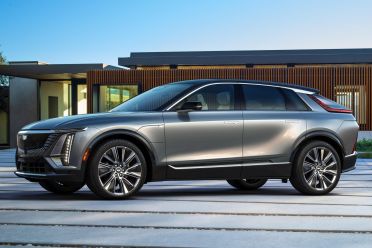Chevrolet will use its vaunted SS nameplate on an electric vehicle for the first time.
The 2024 Chevrolet Blazer EV SS crossover has been teased ahead of its July 18 reveal.
It’ll serve as the performance flagship of the Blazer EV range, which will be available in the US in the northern spring of 2023.
Rather than release an oblique close-up teaser of, say, a headlight, Chevrolet has published a revealing front three-quarter image of its upcoming Ford Mustang Mach-E rival.
Though the image includes a disclaimer that this is a pre-production vehicle, this looks production-ready.
There’s a curvaceous body with a flowing beltline, à la the Volkswagen ID.4, but it’s punctuated with sharp creases.
For example, there’s a distinctive feature line that forms an arc across the front fender, dips down for the doors, and then curves up again to exaggerate the Blazer EV’s haunches.
A dramatic cutout also sits behind the front wheel arch, and houses the charging port.
Up front, there’s a blacked-out grille treatment for a sporty look, as befitting the SS nameplate, while an illuminated Chevy bow-tie badge is linked to the headlights by a light bar.
While the interior hasn’t been revealed yet, it could feature a similar design to the upcoming Equinox EV, also set for a 2023 launch.
The smaller electric SUV, which Chevrolet says should start from US$30,000 (A$43,249), features a driver-oriented cockpit with two large displays angled towards the driver.
The Equinox EV’s targeted base price is around US$5000 more than the base petrol Equinox, and US$3000 less than the base petrol Blazer.
Both the Blazer EV and Equinox EV are expected to use the new BEV3 platform, which debuted on the Cadillac Lyriq, along with GM’s Ultium battery and electric motors.
The Lyriq is powered by a single rear-mounted electric motor with 254kW of power and 441Nm of torque, while an upcoming dual-motor all-wheel drive variant will offer around 373kW.
It features a near 50/50 weight distribution, plus five-link front and rear suspension and a 100kWh battery.
The Lyriq supports DC charging at up to 190kW, with electric range for the rear-wheel drive model totalling a claimed 502km.
Chevrolet is launching the Blazer EV and smaller Equinox EV as dedicated electric vehicles to sell alongside its existing, petrol-powered Blazer and Equinox.
The Blazer nameplate returned in 2019 on a large, two-row SUV, slotting in between the mid-sized Equinox and the almost 5.2m-long three-row Traverse.
Though the Blazer nameplate was previously used on several generations of more rugged, body-on-frame SUVs, the current model is a unibody crossover sharing a platform with the GMC Acadia and wearing design cues from the Chevrolet Camaro.
No SS variant is available, though it was the first Chevrolet SUV to be offered in sporty-looking RS guise.
The Blazer’s sporty image will help Chevrolet market its mechanically unrelated electric counterpart as a rival to the Mustang Mach-E.
The SS, or Super Sport, nameplate dates back to 1961, when it was introduced as an optional performance package for the full-sized Impala.
It’s been widely used by Chevrolet since then. The Nova SS and Chevelle SS were iconic muscle cars, while V8-powered Holden VF Commodores were sold in the US simply as the Chevrolet SS.
There has been an SS SUV before, too, as well as an SS version of the Silverado pickup.
With the 2006-09 TrailBlazer SS, a rival for the Jeep Grand Cherokee SRT-8, Chevrolet stuffed a 295kW 6.0-litre LS2 V8 into a body-on-frame SUV and lowered and stiffened the suspension.













